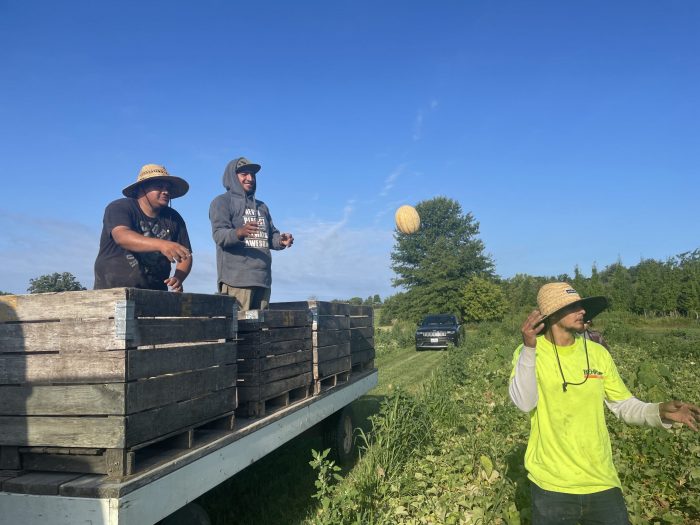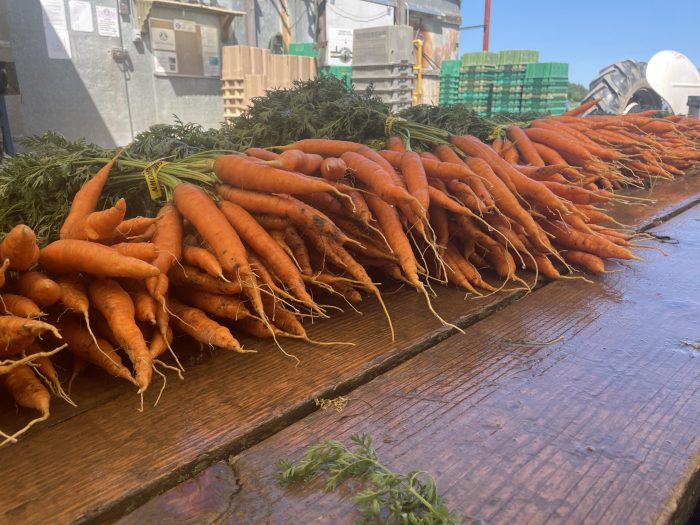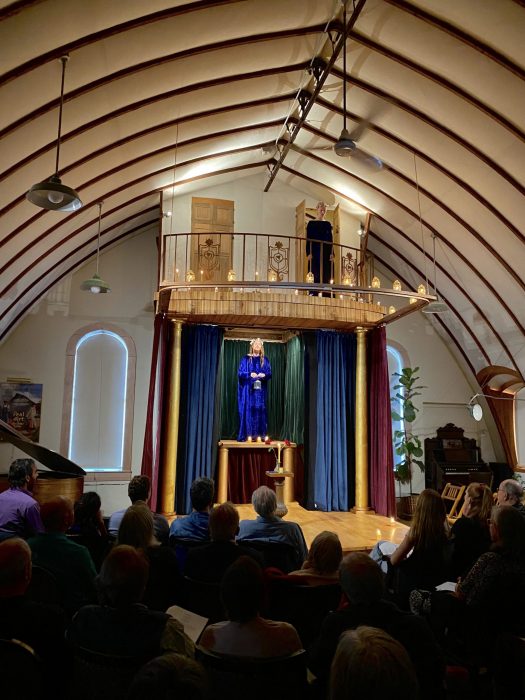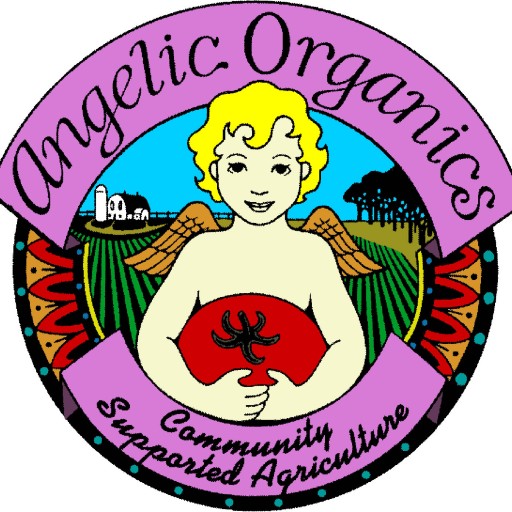Farmer John Writes: I Wasn’t Going to, But…
Harvest Week 6, August 8th – 13th, 2022
Muskmelons

great muskmelon crop this year
Carrots: What’s the Point?
We have a silty clay loam soil that is prone to compaction. Carrots burrow into the earth. When they encounter the resistance of the soil just a few inches deep, they stop growing downwards. They become stubby. Why, then, are our carrots typically not stubby?

Our carrots tend to be long and pointed because we seed them over a slit we make with our subsoiler. This opening is about 14 inches deep. (Learn more about the subsoiler and see subsoiler photos here.) But then, you might wonder, how can we possibly seed the carrots exactly over this slit?
We have a Global Positioning System that is very precise—precise to the inch. It is referred to as RTK, or Real Time Kinematics. The tractor goes up and down the field, steered by this RTK system, deviating (ideally) no more than one inch from the pre-determined grid. Then we seed our carrots in the exact same location in the bed where the subsoiler has run, and the carrots have a receptive crevice of soil into which they can freely descend. (Extracting the carrots from their bed without breaking the tips is a bit of a challenge. When you receive a broken carrot, its tip is likely still embedded in the soil.)
We use this RTK system to lay out all of our beds, to avoid soil compaction, and to ensure that the tires of our heavy tractors straddle the growing part of the beds. This deep penetration of the soil also helps to let water in, and helps to oxygenate the soil, a boon for soil microbes.
When you think of soil stewardship, I doubt that RTK is the first thing that comes to mind. However, soil compaction can limit yields (and carrot length) dramatically. The less we drive on the growing part of the bed, the more aerated and flocculant is the bed. (Flocculant usually turns heads when I say it, but it is a hardy, old-fashioned word; it refers to a process in which clay and other soil particles form larger groupings or aggregates, thereby coarsening the soil texture and making heavier soils easier to cultivate.)

RTK receiver on top of tractor cab
RTK is not impeccable technology, because it relies on the triangulation of signals from the sky and a distant tower. It works okay for the most part; when it doesn’t, you might get a stubby carrot. When you receive a nice, long pointy carrot, you can exclaim “Thank Heavens!” though I’m not really sure that satellites inhabit even a tiny slice of heaven.
You Can Order More
When you customize your box up to its value of $40, you may still have the option to purchase more of certain items. To purchase more of an item, simply increase the quantity of the item during the customization window. When you exceed the $40 minimum during customization, an alert will appear on screen where you will be asked to accept the additional charges. These items will probably include sweet corn for the next several weeks, and probably several additional items, depending on the week. I especially like to make extra sweet corn available for purchase, because I know that some of you have gatherings featuring sweet corn, and we have fabulous sweet corn once again.
When we make these items available for purchase, it sometimes requires that we tape two boxes together to fill your order—it slows down the pack line, but we’re happy to be a supplier for your party.
Visit Our U-Pick Garden
Flowers, beans and herbs are yours for the taking. Click here for details.

U-Pick Garden
I Wasn’t Going to Do This for Farm News, But…
My 50-year Beloit College Reunion is coming up this fall, and the Alumni Department of Beloit College asked me to present on my life over Zoom to fellow alumni. I did the presentation a couple of weeks back, with the fabulous cinematic help of my assistant, Amanda. The presentation is geared to Beloit alumni, especially their influence on the farm here from the late 60’s on.
Sharing the presentation with our shareholders is a little bit like letting you read a letter that I wrote to someone else, but there is still a lot of relevance that does not apply directly to Beloit alumni. It layers the present in with the past, and the past in with the present.
In a certain way, it’s a homemade movie by me about my farm and my life, which took mere days to make, unlike The Real Dirt on Farmer John which was a collaborative effort with the director and assorted editors and producers, which took years to make.
The full video presentation is 65 minutes long. You will see a lot of our farm equipment, our repair shop, some of our fields, the farmstead, renovated barn interior, and schoolhouse exterior (where my wife Haidy and I live), complete with stories.
We also created a 20-minute addendum featuring the interior of the schoolhouse. Both videos offer a perspective on the farm that is not available elsewhere. It’s another way to get to know your farm and your farmer.
Note about the gathering spaces in the presentation: we are not a public venue. We are not an official or public event center. We do not have authorization from the authorities to charge admission or to host public events. We are often encouraged to host weddings, but again, we do not satisfy the legal criteria to be an event center.
That’s a whole other realm that we don’t plan to enter into. For starters, it would probably take between a half million and a million dollars to become ADA compliant. The debut of the musical group called Velsum pictured below was a private gathering with no admission charge, sort of like inviting friends over to our living room to watch a show.

Friends of the farm Lucien Dante Lazar and Ultra-Violet Archer of Velsum debuted their songs in the barn loft theater this spring
Another element in this consideration is that farming takes pretty much all the attention and all the energy here, so cultural activities unfortunately tend to be infrequent on the farm.
We do, however, hope to have some sort of live performance on our stage at our upcoming fall open house—more on that soon.
Warmly,
Farmer John




The state corn growers have a competition every year to see who gets maximum yield from corn. One of the key methods is minimizing soil compaction. It is hard for anyone to comprehend the degree of stewardship required to avoid excessive soil compaction and keep tillage in the sweet spot required to keep down weeds and keep soil loose. My first year attempting to transition a few acres organic resulted in my son and I finally driving our newly purchased (used) equipment up to an early summer field crowded with seven foot high ragweed. (Most nearby farmers refused to take payment to clear the field due to concerns about ragweed ruining the paint job on their running gear. The reason for that concern soon became evident.) Sweating it out if the soil was to wet after rain, or to dry, or to close to the willows in the draw (it was) was the ultimate in thrilling adventure. This on top of keeping 200 mile round trips to a minimum; feeding the engine to the tune of 5 gallons per hour to avoid losing fuel pump prime, learning about keeping a recalcitrant monstrous tractor tire inflated; and, wondering if the horse farm down the road (owned by Dixon’s treasurer) would keep giving us free manure to spread. Needless to say we gave it everything we had but you have not lived until you try moldboard plowing for the first few times and suddenly the front tires lift off the ground four feet while in motion. Farm education is swift and harsh but as my grandpa used to say “the lord looks after fools and small children!”. We did survive by the skin of our teeth but retired from the field of battle without much of a crop and without certification. Again, so grateful to have people like Farmer John and his superb crew!
Jeff, I love this raw and literary account of goin’ farmin’. I figure about 20 years of experience are needed for someone to get good enough at farming to maybe make a go of it. i was told recently that any kid with an interest in farming could easily take my place. It reminded me of how many people think that knowing how steering a tractor is the same as driving it. I suppose around the 20th year or so, the work starts to penetrate the material and seep onto a more cosmic realm, where the earth speaks and gets heard, and the machinery emits mystical subtleties that prevent damages, because we can hear them, feel them.